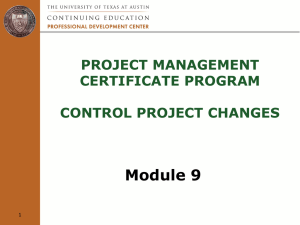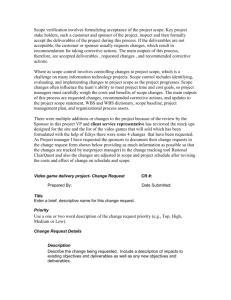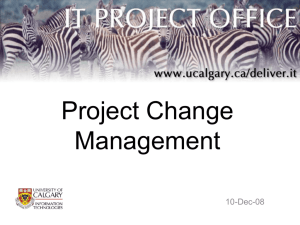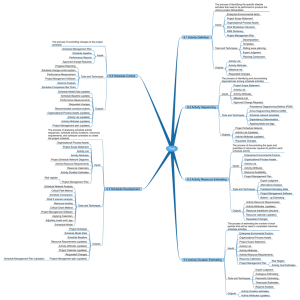Lecture 12
advertisement
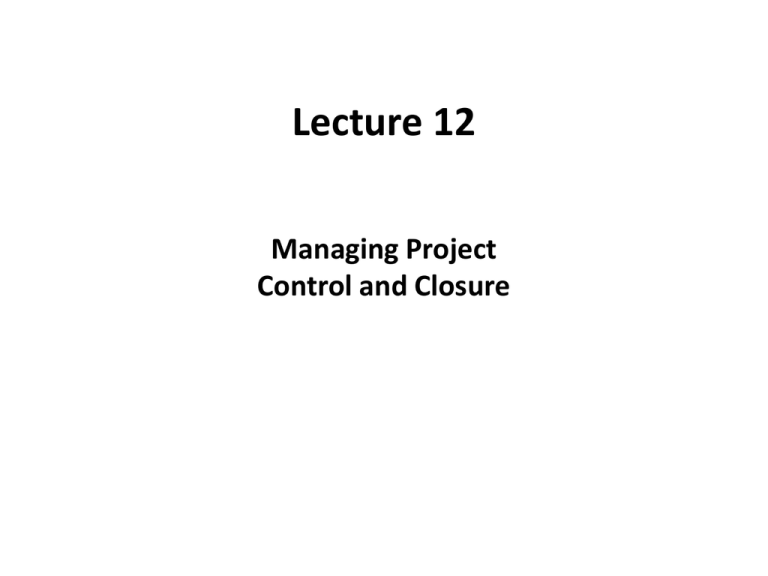
Lecture 12 Managing Project Control and Closure Project Control • The process that allows monitoring and measurement of project progress and directing influence over the plan to account for any discrepancies between planned progress and actual progress Philosophy of Project Control • The management style the manager employs in following the plan and dealing with problems or changes in the plan • Types: – Dogmatic • Little or no tolerance for deviation from the original plan – Laid-back • Allows any changes or problems that arise, attempting to make numerous changes along the way to allow for the multiple problems and changes – Pragmatic • A compromise between the dogmatic and laid-back philosophies that sticks to a plan, but is flexible enough to allow for changes Philosophy Determinants • Project size • Level of value or importance • Risk • Number of stakeholders Levers for Controlling Projects • Communication – Flow and quality • Participation – Team member contribution level as well as those of the stakeholders • Analysis and action – Project leader’s ability to understand a given situation and take appropriate action • Commitment – Buy-in by team members and stakeholders Project Closure • Final implementation and training related to the project, getting acceptance and signoff on the project, and archiving the results of the project and lessons learned from it Importance of Project Closure • Signifies the official end to the project • Involves: – – – – – System installation Training for end-users/support staff Documentation and archiving project Management methods applied Lessons learned Techniques for Managing Project Control • Standard Operating Procedures – Activities and reporting methods instituted during the course of the project to monitor its progress and to provide reports for project managers and stakeholders – Project log • Recordings of project activities – Progress report template • Communication to stakeholders on project activities – Monitor and control project work processes Monitor & Control Project Work • The process of collecting, measuring, and disseminating information related to performance, as well as assessing measurements and trends in order to make any improvements Monitor & Control Project Work Processes Inputs • Project management plan – Defines how the project will be executed, monitored and controlled, and closed • Work performance information – Information indicating the status of project activities yet to be completed • Rejected change requests – Change requests, supporting documentation, and rejected justification Monitor & Control Project Work Processes Techniques • Project management methodology – The process that helps the project team monitor and control the work being performed in accordance with the project management plan • Project management information system – MS Project or similar tools • Earned value technique – A cost-control technique that provides estimates on the likelihood the project will meet schedule and budget requirements • Expert judgment – Recommendations by skilled and experienced personnel related to monitoring and controlling project work activities Monitor & Control Project Work Processes Outputs • Recommended corrective actions – Documented recommendations needed to bring future project performance into conformance with the project management plan • Recommended preventive actions – Documented recommendations that minimize the probability of negative consequences to the project • Forecasts – Estimates or predictions of conditions or events in the project’s future • Recommended defect repair • Requested changes Integrated Change Control • The process of identifying, evaluating, and managing changes that occur from project initiation through project closure Integrated Change Control Inputs • Project management plan • Requested changes • Work performance information • Recommended preventive actions • Recommended corrective actions • Recommended defect repair • Deliverables Integrated Change Control Tools & Techniques • Project management methodology • Project management information system • Expert judgment Integrated Change Control Outputs • Approved change requests – Documented and authorized changes that are scheduled for implementation by the project team • Rejected change requests – Requested changes that were not chosen for implementation • Approved corrective actions – Documented and authorized guidelines necessary to bring future project performance in conformance with the project management plan • Approved preventive actions – Actions to reduce the probability of negative consequences to the project due to identified risks • Approved defect repair – Approved and authorized actions that are recommended to correct defects in the project deliverables Project Control Techniques 1. Scope control 2. Schedule control 3. Cost control 4. Quality control 5. Risk monitoring and control 1. Scope Control • The process of assuring that only agreed-upon changes are made to the project’s scope Scope Control Process Inputs • Scope statement – Defines the current boundaries of the project • Work breakdown structure – Project divided into work packages • WBS dictionary – Work package content defined • Scope management plan – Document that describes how the project scope is defined, documented, verified, managed, and controlled during the project life cycle Scope Control Process Inputs (cont.) • Performance reports – Describe what the project team has accomplished so far in terms of the deliverables that have been completed • Approved change requests – Agreed-upon modification to the project scope baseline • Work performance information – Indication of the status of the different activities required to complete the project Scope Control Process Tools & Techniques • Scope change control system – Formal, documented process that describes the procedures for changing the project scope and product scope • Scope variance analysis – Identifying the cause of variance relative to the project baseline and determining whether any corrective action is needed • Scope reporting system – Process of periodically ascertaining and documenting the status of cost, schedule, and technical (quality) performance • Configuration management system – Guidelines that ensure that the requested changes to the project and product scope are thoroughly considered and documented before being implemented Scope Control Process Outputs • Updates to project scope statement • Updates to WBS • Updates to WBS dictionary • Updates to scope baseline • Requested changes • Recommended corrective action • Updates to organizational process assets • Updates to project management plan 2. Schedule Control • The process of setting procedures and rules in place for controlling changes to the project schedule Schedule Control Inputs • Schedule management plan – Specifies how the project schedule will be managed and controlled • Schedule baseline – Used to measure and report schedule performance • Performance reports – Describe what the project team has accomplished so far in terms of the planned dates that have been met and those that have not • Approved change requests – Agreed upon modification to the agreed upon schedule baseline Schedule Control Tools & Techniques • Progress reporting • Schedule change control system • Performance measurement • Project management software • Variance analysis • Schedule comparison bar charts Schedule Control Tools & Techniques • Progress reporting – Documenting what the project team has accomplished during a certain period of time • Schedule change control system – Process for evaluating and implementing potential schedule changes, including change approval authorization hierarchies • Performance measurement – Determine the magnitude and criticality of schedule variations Schedule Control Tools & Techniques (cont.) • Project management software – Tracks project schedules or forecast the effects of variations in activity completion dates • Variance analysis – Evaluate potential and/or actual variance on the project schedule • Schedule comparison bar charts – Displays the status of an activity based on the schedule baseline and the current status of the same activity Schedule Control Outputs • Schedule updates • Performance measures – Stakeholders informed • Requested changes • Recommended corrective actions – Procedures initiated to address schedule performance problems Schedule Control Outputs (cont.) • Updates to organizational process assets – Causes of variance documented; justification for correction action; lessons learned • Updates to activity list • Updates to activity attributes • Updates to project management plan – Project schedule is brought up-to-date to reflect approved schedule changes 3. Cost Control • The process of ensuring that only appropriate changes are included in the modified cost baseline • Cost baseline Cost Control Inputs – Time-phased budget that is used to measure and monitor cost performance • Project funding requirements • Performance reports – Provides information related to cost and resource performance as the project is executed • Work performance information – Status and cost of the different activities required to complete the project • Approved change requests • Project management plan Project Funding • Estimates can be: – Top-down: spending limit is set by senior management – Bottom-up: costs are totaled for each project activity which provides the estimated total cost of the project Cost Control Tools & Techniques • Cost control change system – the procedures by which changes can be made to the cost baseline just as the schedule change control system is used to provide procedures for making changes to the schedule • Performance measurement analysis – Assesses the magnitude of any variance occurring during project execution (e.g. EVM) • Forecasting – Estimates or predictions of conditions or events in the project’s future that are determined from information and knowledge available at the time of the forecast Cost Control Tools & Techniques (cont.) • Project performance review – Assessment cost performance over time, the activities that are running over or under budget, and milestones that have been met and those that remain to be met • Project management software – Assists project team in monitoring planned performance against the actual performance and to forecast the effects of any changes on the planned project cost • Variance management – Specifies how changes to the cost baseline will be managed Cost Control Outputs • Updates to cost estimates • Updates to cost baseline • Performance measurements – Reported to key stakeholders • Forecasted completion • Requested changes Cost Control Outputs (cont.) • Recommended corrective actions • Organizational process assets updates – Causes of variances identified; justification for corrective action; and lessons learned • Updates to project management plan Earned Value Management (EVM) • Variance analysis technique that tracks the physical accomplishment of work. EVM can measure technical performance (i.e., accomplishment of planned work - scope), schedule performance (i.e., behind/ahead of schedule - time), and cost performance (i.e., under/over budget - cost) EVM Known's • Planned value (PV) How much work you planned or budgeted to have accomplished (in dollars) by now or at a given point of time • Actual cost (AC) How much you have actually spent by now (in dollars) 4. Quality Control • The process of screening the project results to determine whether they conform to relevant quality standards and identifying means to eliminate causes of unsatisfactory results Quality Control Inputs • Quality management plan – specifies how quality measures will be implemented during a project • Quality metrics – Defines specific processes, events, or products, and include an explanation of how they will be measured in terms of quality • Quality checklists – Documentation that ensures a specific set of actions necessary for quality control has been correctly performed Quality Control Inputs (cont.) • Organizational process assets – Lessons learned from previous projects • Work performance information – Technical performance measures, project deliverables completion status, and the implementation of the required corrective actions • Approved change requests – An agreed upon modification of the quality management plan • Deliverables – Any unique and verifiable product of a process that is defined in the project management plan Quality Control Tools & Techniques See Chapter 8 for Review • Cause-and-effect diagrams • Control charts • Flowcharts • Histograms • Pareto charts • Run charts • Scatter diagrams • Statistical sampling • Inspection • Defect repair review Quality Control Outputs • Quality control measurements – Results of the quality control process activities used in the quality assurance process for a reevaluation of the quality standards • Validated defect repair – Re-inspection of repaired items to determine whether they can be accepted or rejected based on established project quality standards • Updates to quality baseline – Quality baseline is updated to reflect any changes • Recommended corrective actions – Documented and authorized guidelines necessary to bring the quality of project deliverables in conformance to the standards • Recommended preventive actions – Actions to reduce the probability of nonconformance to the standards Quality Control Outputs (cont.) • Requested changes – Change requests triggered by quality control processes • Recommended defect repair – Defects in project deliverables are identified and recommended for repair • Updates to organization process assets – The causes of variances, the justification for any corrective action, and any lessons learned during the perform quality control process are added to the historical database • Validated deliverables – Quality of the project deliverables is compared to set standards with those that conform to the standards being accepted • Updates to project management plan – Additions to reflect the approved changes to the quality management plan resulting from the perform quality control process 5. Risk Monitoring and Control • The process of identifying, analyzing, and planning for new risks, keeping track of identified risks, reanalyzing existing risks, monitoring trigger conditions for contingency plans, monitoring residual risks, and reviewing the execution of risk responses Risk Monitoring and Control Inputs • Risk management plan – Information pertaining to assignment of people, including the risk owners, time, and other resources to project risk management • Risk register – Identifies risks and risk owners, agreed-upon risk responses, specific implementation actions, warning signs of risk, residual and secondary risks, and the time and cost contingency reserves • Approved change requests – Modification to risk management plan • Work performance information – Project deliverable status, corrective actions, and performance reports • Performance reports – Documented work performance information that may influence risk management processes Risk Monitoring and Control Tools & Techniques • Risk reassessment – Periodic reviews to identify new or changing risks • Risk audits – Evaluates effectiveness of risk strategies as well as risk owners • Variance and trend analysis – Identifies deviations from the baseline plan • Technical performance measurement – Metrics used to measure goals associated with specific project milestone • Reserve analysis – Comparison of the amount of contingency reserves remaining to the amount of risk remaining at any time in the project • Status meetings – Inclusion of risk management discussions during project team meetings Risk Monitoring and Control Outputs • Updates to risk register – Outcomes of risk assessments, risk audits, and periodic risk reviews added to risk register • Requested changes – Requested modifications to risk management plan • Recommended corrective actions – Contingency and workaround plans for emerging risks • Recommended preventive actions – Actions to bring project into compliance with project plan • Updates to organizational process assets – Causes of variances, justification for corrective actions and lessons learned are added to historical database • Updates to project management plan – Project management plan is updated to reflect approved changes related to risk management Project Closure 1. End report – 2. Document that contains a record of the project management techniques employed over the course of the project, surveys, and outstanding items that still need to be resolved Post-implementation review – 3. Document that is usually completed 6 to 12 months after implementation as a check on whether the outcomes of the project were as expected, whether ongoing costs are as expected, and whether implementing the product yields net benefits Handover – Completed project is delivered to the client and personnel are trained on the new system End Report Questions?
